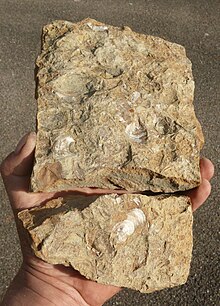Psilonotenton Formation

Abbreviations:

The Psilonotenton Formation is the basal lithostratigraphic formation of the southern German Jura . It is underlain by the Oberkeuper , and regionally differently overlaid by the Angulate Clay Formation or Angulate Sandstone Formation . In Franconia it meshes with the Bamberg formation . It reaches a thickness up to about 12 m and is dated in the Unterhettangium .
history
The term Psilonotenton was already used by FA Quenstedt 1856-57 and equated with its stratigraphic unit Lias alpha1 . It is named after the ammonite Psiloceras psilonotum that occurs in the bottom bank . A type locality, as it is actually required to define a lithostratigraphic unit, has not yet been determined.
definition
The Psilonotenton-Formation mainly consists of claystones with some embedded siltstone banks, silty-sandy limestone banks or limestone banks with chamositoids . The thickness varies in the area of the Swabian Alb between 4 and 10 m. In the Upper Rhine area, the thickness can drop below 1 m. The base of the formation is formed by the 30-40 cm thick Psilonotenbank . It is a condensation horizon that includes several ammonite subzones. There is a layer gap between the underlying Oberkeuper and the Psilonotenton formation. The upper limit is formed by the lower edge of the so-called oolite bank, the basal bank of the subsequent Angulate clay formation or the Angulate sandstone formation interlocking with this formation .
Temporal scope and distribution area
The sediments of the Psilonotenton Formation were deposited during the Unterhettangian and comprise the ammonite zone of the Psiloceras planorbis (see Planorbis zone ). However, the basal parts of the Hettangium (or the Jura ) are missing . Ammonites of the Neophyllites horizon below the Psiloceras planorbis subzone have only been found in a few profiles . The horizons of Psiloceras erugatum and Psiloceras tilmanni (so-called preplanorbis layers, Tilmanni zone ) have not yet been identified in any profile of the southern German Jura .
The formation is widespread in the Swabian Alb and extends to the Upper Rhine Valley Trench, where it becomes very thin. It meshes with the Bamberg formation in Franconia . There is a small gap between the Psilonotenton Formation and the overlying Angulate Sandstone and Angulate Clay Formations.
Breakdown
The Psilonotenton formation is subdivided into the actual Psilonotenton and the Psilonotenbank. In the Esslingen - Mutlangen region, a thin sandstone turns in about the middle of the formation (Esslingen-Mutlangen sandstone).
Fossil guide
Within the formation, only the psilon bank at the base of the formation is fossil-rich (with well-preserved ammonites and rare mussels ).
literature
- Gert Bloos, Gerd Dietl & Günter Schweigert: The Jura of Southern Germany in the Stratigraphic Table of Germany 2002 . In: Newsletter on Stratigraphy . tape 41 (1-3) , 2005, ISSN 0078-0421 , pp. 263-277 .
- Eckhard Mönnig: The Jura of Northern Germany in the Stratigraphic Table of Germany 2002 . In: Newsletters on Stratigraphy . tape 41 (1-3) , 2005, ISSN 0078-0421 , pp. 253-261 .
- Friedrich August Quenstedt: The Flözgebirge Wuerttemberg . Laupp Publishing House, Tübingen 1843.
- Friedrich August Quenstedt: The Jura . Laupp Publishing House, Tübingen (1856-57).
- Stratigraphic table of Germany 2002 . (PDF; 6.6 MB) German Stratigraphic Commission, Potsdam 2002, ISBN 3-00-010197-7
Web links
- Geological overview of the sequence of layers in Baden-Württemberg (PDF; 183 kB)
- Lower Jurassic in Baden-Württemberg ( Memento from September 15, 2011 in the Internet Archive ) (PDF; 12 kB)
- The oldest Jurassic ammonites in Europe (PDF; 495 kB)
- Tsunami over Tübingen